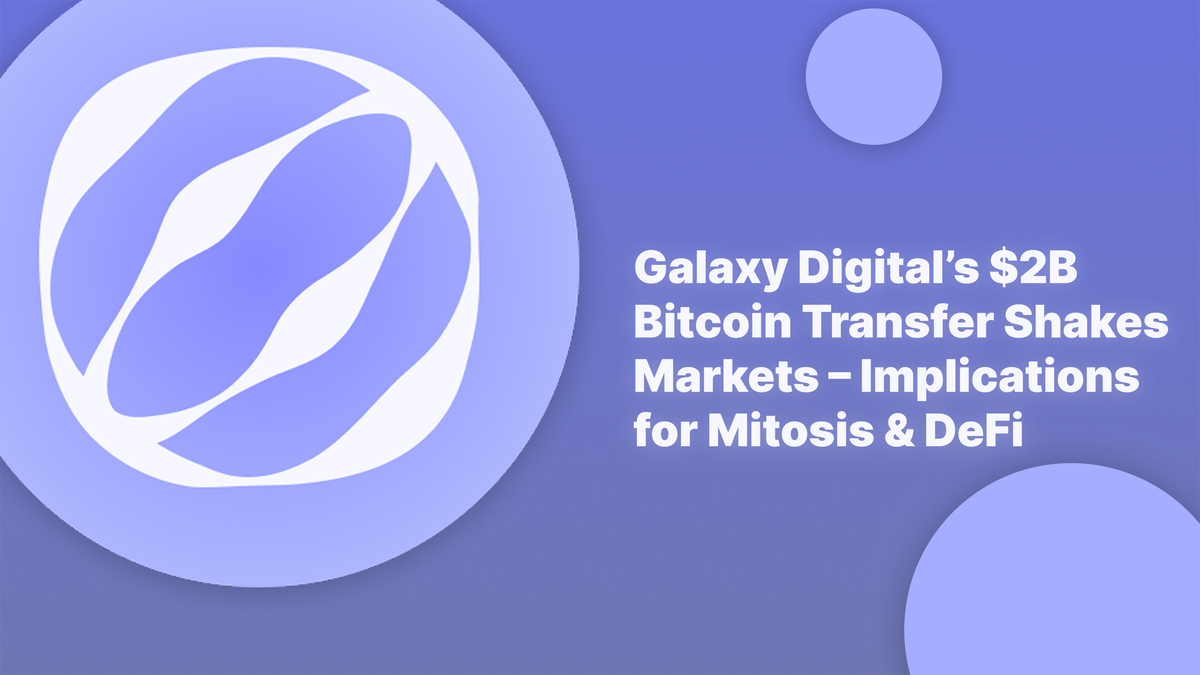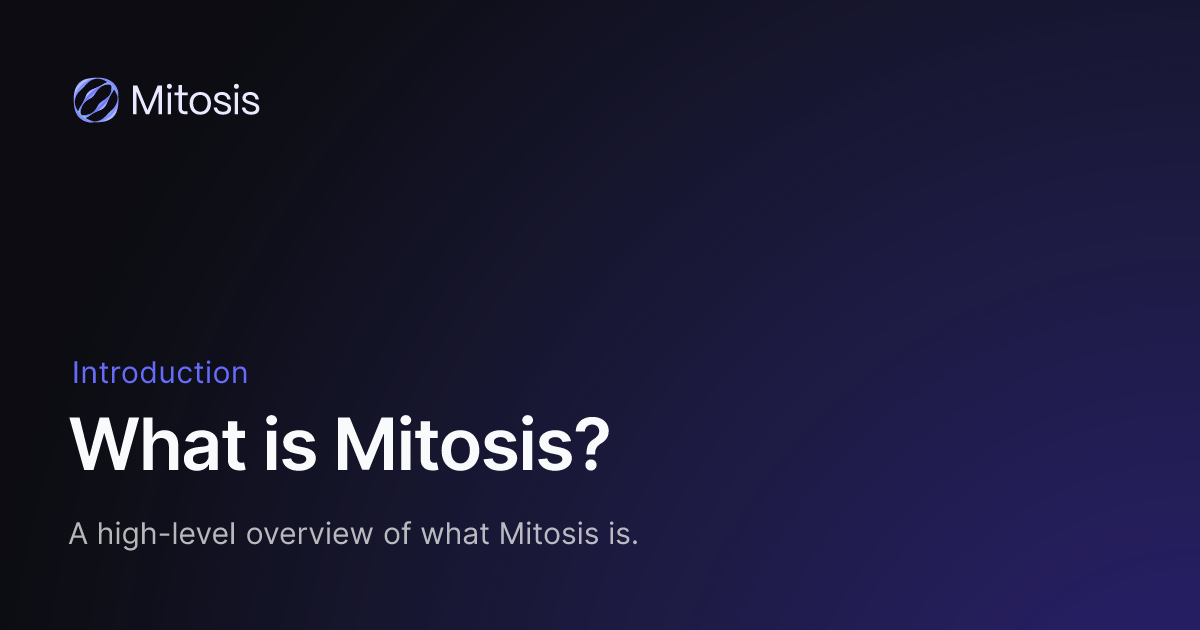Galaxy Digital’s $2B Bitcoin Transfer Shakes Markets – Implications for Mitosis & DeFi

Introduction: A Whale Move Sends Ripples Across Crypto
In late July 2025, Galaxy Digital – the crypto investment firm led by Mike Novogratz – made headlines with an eye-popping transfer of 17,123 BTC (roughly $1.98 billion) to multiple centralized exchanges (CEXs) in the span of just 12 hours. Such a massive whale move immediately raised alarms across the Bitcoin community. Were these coins on the move to be sold, potentially triggering a market-wide dump? The context made the transfer even more intriguing: the Bitcoin originated from a long-dormant Satoshi-era whale wallet, which had handed over 80,000+ BTC to Galaxy Digital after 14 years of inactivity. As Galaxy distributed over 10,000 BTC to exchanges within 8 hours and continued with thousands more soon after, traders braced for turbulence. In parallel, on-chain analysts noted Galaxy withdrawing some $370 million in USDT from exchanges (likely sale proceeds) – a strong signal that an institutional-scale sell-off was underway, not merely a custodial reshuffling of funds. This introduction sets the stage for a closer look at how the market responded to Galaxy’s big move and what it reveals about broader crypto trends. Crucially, we’ll also explore how these dynamics connect to Mitosis’s DeFi ecosystem – touching on liquidity strategies, DeFi stability, interoperability, and how a platform like Mitosis can play a role during bouts of extreme volatility.

Market Reaction: Price Volatility and Investor Sentiment
News of Galaxy Digital’s rapid Bitcoin offloading quickly reverberated through the markets. Within a day, Bitcoin’s price slipped over 2%, falling from an attempted breakout near $119,000 down to about $115,600. By press time, BTC hovered around $115,440 – roughly 4% lower week-over-week. This abrupt drop from local highs rattled investors and injected a dose of caution into what had been a largely bullish climate. Analysts noted that Galaxy’s “sell-off spree” had clearly weighed on Bitcoin’s price, stoking short-term bearish sentiment in the market. Order books on major exchanges were tested as thousands of BTC hit the market; one observer quipped that liquidity pools were getting a stress test, with even high-cap coins like BTC “trading like a meme stock when whales cough” – a cynical reminder of how big players can still jolt crypto markets.
Investor reactions ranged from nervousness to opportunism. On social media, some traders fretted that this could be a signal of further downside, especially if Galaxy (or its whale client) continued to offload holdings. Technical analysts pointed to ~$114,000 as a key support – warning that a breakdown below that level could trigger even more selling pressure and momentum to the downside. On the other hand, some saw the dip as a buying opportunity, noting that Bitcoin’s overall uptrend remained intact despite the shake-up. It’s worth noting that episodes of large-scale selling are not new in crypto; even amid a broader bull market, sharp corrections can occur when early holders or institutions decide to realize profits. The fear and greed pendulum can swing quickly – a day prior, market sentiment was buoyant with talk of new highs, yet Galaxy’s move unleashed a wave of short-term fear. This whipsaw in mood underscores a broader truth in crypto: volatility is the price of admission for outsized gains. As long-time crypto advocate Arthur Hayes recently suggested, Bitcoin’s road to potential new heights (he famously envisions prices as high as $250K) will inevitably be punctuated by aggressive sell-offs and consolidations. In other words, while macro bullish forces may be in play, traders must weather these intermittent storms. The key question is whether the crypto market’s infrastructure and participants are becoming more resilient to such shocks – and what role the growing DeFi ecosystem might play in cushioning (or capitalizing on) the volatility.

Broader Trends: Liquidity, Whale Behavior, and Crypto Market Maturation
Galaxy Digital’s multi-billion-dollar transfer shines a spotlight on several broader trends in the crypto industry. First is the ever-increasing presence of institutional and whale activity. In 2025, it’s not just retail traders or small whales moving the needle – major firms and ancient wallets hold sway. The fact that a single entity could move nearly $2B in Bitcoin in half a day, and that this move was detected in real-time by on-chain analytics (e.g. Lookonchain’s alerts), speaks to how transparent and quickly-reacting the crypto markets have become. We’re in an era where whale wallets are closely watched in real time, and large transfers immediately spark speculation about intent (be it profit-taking at cycle highs or foreboding bearish signals). This particular case – an old “fossil” Bitcoin hoard finally coming into circulation – also suggests that as prices reach new all-time highs, even the most steadfast HODLers may be tempted to sell, injecting supply into the market. Such events can mark turning points or at least temporary ceilings in bullish runs, as supply and demand rebalance.
Secondly, Galaxy’s reliance on centralized exchanges highlights the ongoing dynamic between CeFi and DeFi liquidity. Despite the rise of decentralized exchanges, the deepest pools of liquidity for selling tens of thousands of BTC still reside on major CEX venues like Binance, Coinbase, Kraken, or others. Galaxy’s coins were distributed across multiple CEXs to avoid overwhelming any single order book, yet the coordinated dump reinforces that large players still view centralized exchanges as the primary off-ramp for size. This centralized choke point reality has implications for crypto volatility: even if DeFi grows, a few big exchanges can heavily influence price discovery when whales act. The episode serves as a reality check that crypto’s “decentralized finance” narrative is still maturing – for now, big moves by institutions often bow to centralized liquidity hubs. However, it also underscores an opportunity: if decentralized liquidity can deepen across chains, future whales might not need to send coins to CEXs at all, potentially smoothing out some of these shock events. This is where projects focusing on cross-chain liquidity and interoperability – like Mitosis – enter the conversation.
Finally, the market’s relatively orderly 2-4% drop in response to a $2B sell event could be seen as a sign of growing market depth and maturity. In earlier years, such a massive sell might have triggered double-digit percentage crashes. That Bitcoin only slipped a few percent suggests a lot of buyers were waiting on the sidelines (perhaps with bids layered around the mid-$110K range), and arbitrage bots swiftly stepped in to buy the dip on exchanges where prices deviated. It’s a small but encouraging signal that crypto markets are getting better at handling large flows – thanks in part to more sophisticated participants, better risk management, and yes, the expansion of liquidity across venues. This more tempered reaction can also be attributed to clearer heads in the investor community: many understand that one whale selling doesn’t derail the fundamental bull trend (especially if macro conditions like monetary expansion remain favorable, as Hayes and others argue). In summary, the Galaxy incident encapsulates a market at the crossroads of old and new: old whales taking profit and using centralized routes, new on-chain transparency and DeFi options emerging as counterbalances. This brings us to how Mitosis’s ecosystem ties into these developments.

Mitosis Ecosystem Perspective: Navigating Volatility with Cross-Chain Liquidity
High-profile sell-offs like Galaxy Digital’s BTC transfer don’t just move markets – they also provoke important questions about liquidity strategy and stability in the crypto ecosystem. For Mitosis, a Layer-1 protocol purpose-built for cross-chain liquidity and DeFi interoperability, events like this highlight both challenges and opportunities. Mitosis is often described as “the network for programmable liquidity,” designed to optimize and connect liquidity across multiple blockchains. In practical terms, that means Mitosis enables users and dApps to seamlessly move assets and liquidity across chains – breaking down the silos that often fragment capital. In moments of extreme volatility, this capability can be invaluable. Here’s how Mitosis and similar cross-chain platforms could play a role during whale-induced turbulence:
- Unified Liquidity & Arbitrage: By facilitating cross-chain liquidity transfer, Mitosis helps ensure capital isn’t stuck in one ecosystem when it’s needed in another. Liquidity that can flow freely is liquidity that can fill the gaps when one exchange or network is hit with heavy selling. For example, if Bitcoin prices briefly diverge between exchanges (or between a CEX and a DEX on another chain) due to a large dump, arbitrageurs can use Mitosis to swiftly bridge assets and take advantage of price differences. This not only presents profit opportunities but also naturally pushes prices back toward equilibrium, adding stability. In essence, cross-chain protocols reduce liquidity fragmentation, making the overall crypto market more efficient and resilient. Mitosis’s architecture – which uses programmable liquidity allocation to optimize movement across Ethereum, Layer-2s, and even Cosmos-based chains – is built for this kind of fluid response.
- DeFi Stability Mechanisms: During volatile episodes, decentralized liquidity protocols can act as shock absorbers. Mitosis introduces concepts like Ecosystem-Owned Liquidity (EOL) and Matrix Vaults, which collectively manage and deploy liquidity with governance input. In a sell-off scenario, an EOL framework could theoretically vote to deploy more liquidity to certain pools (or even support certain assets) to counteract sudden imbalances. While a single platform can’t fully counter a determined whale, a network of platforms coordinating liquidity can mitigate some impacts. Moreover, because Mitosis spans multiple chains, users can quickly rotate into more stable assets or yield strategies on different networks when turbulence hits one chain. This contributes to DeFi stability – the ability to maintain composure (and even decent yields) when centralized markets are swinging. For instance, even as Galaxy’s move stressed CEX order books, liquidity pools on decentralized exchanges (DEXs) might experience large swaps and slippage. A cross-chain liquidity engine like Mitosis could route additional stablecoins into those pools or facilitate users moving to more robust venues, thus reducing overall volatility. It’s about giving traders and protocols the tools to react swiftly in a crisis, without being bottlenecked on a single platform.
- Interoperability & Risk Diversification: One lesson from the Galaxy sell-off is that concentration of funds on a few exchanges can be a vulnerability. Interoperable DeFi platforms encourage a more decentralized distribution of liquidity and risk. Mitosis, by bridging assets across chains, makes it easier for users to avoid over-reliance on any single exchange or blockchain. In times of stress, that means if one ecosystem (say Ethereum or a specific CEX) is experiencing dislocation, value can be transferred to other chains or applications where conditions are calmer. This interoperability acts as a pressure release valve. It’s akin to having a multi-lane highway for liquidity: if one route is jammed or hazardous, traffic can reroute through alternative paths. The Mitosis matrix of interconnected liquidity strives to keep the crypto economy flowing smoothly even when big obstacles appear. As noted in Mitosis University’s glossary, protocols that enable true cross-chain liquidity (like THORChain, LayerZero, Mitosis, etc.) play “key roles in ensuring liquidity can move natively across multiple networks,” thereby enhancing the overall robustness of DeFi markets.
In light of Galaxy Digital’s sell-off, one can argue that the Mitosis ecosystem stands to benefit in a few ways. Investor confidence in DeFi may rise as people observe that decentralized platforms weren’t directly responsible for the volatility – instead, it was a centralized action. This could spur more users to explore liquidity options beyond the big CEXs. Additionally, high volatility often drives users to seek better yields or hedging opportunities, and those are often found in DeFi. A platform like Mitosis, which can deploy liquidity to wherever yields are highest or risk is lowest, might see increased activity as traders rebalance portfolios across chains. Finally, institutional players themselves might take note: in the future, instead of unloading tens of thousands of BTC on a few centralized venues, an institution could choose a more programmatic selling strategy via DeFi channels, using something like Mitosis to drip liquidity out across many networks and DEXs to minimize market impact. Paradoxically, then, the very forces that caused this week’s turbulence could drive innovation in liquidity management – an area where Mitosis is at the cutting edge.

Conclusion: Turning Turbulence into Opportunity
Galaxy Digital’s monumental Bitcoin transfer serves as a vivid reminder that even in a maturing crypto market, volatility and large sell-offs are here to stay. For investors and builders alike, the episode is both a caution and an inspiration. On one hand, it highlights the importance of risk management – big players can move markets, so diversification and vigilance (remember to DYOR and perhaps keep an eye on whale alerts) remain as crucial as ever. On the other hand, events like this showcase crypto’s growing resilience and the creative ways the ecosystem adapts. Despite a multi-billion-dollar shock, the Bitcoin market only wobbled briefly, demonstrating deeper liquidity and wiser heads than in past cycles.
For Mitosis and the DeFi community, the takeaways are clear. Liquidity strategy should be proactive: by uniting liquidity across chains and embracing interoperability, we can build a financial system that’s harder to rattle. DeFi stability isn’t just a lofty goal – it’s an achievable state when protocols coordinate to absorb sell pressure and route assets efficiently. High-profile sell-offs by institutions might rattle centralized markets, but they also underline the value of decentralized, programmable liquidity that Mitosis provides. In the long run, what might seem like a crisis can become an opportunity – an opportunity to prove that decentralized finance can weather the storms and even turn them to its advantage. As Arthur Hayes and other visionaries have suggested, the trajectory for crypto remains skyward (with Bitcoin six-figure prices in sight), but the journey will be volatile. Platforms like Mitosis aim to ensure that, through all the ups and downs, liquidity keeps flowing and users stay empowered across the multi-chain universe. Galaxy Digital’s whirlwind BTC move may have shaken the market in the moment, but it also strengthens the case for a more interconnected and resilient crypto ecosystem – one where no single whale’s splash can sink the ship.
Useful links:














Comments ()